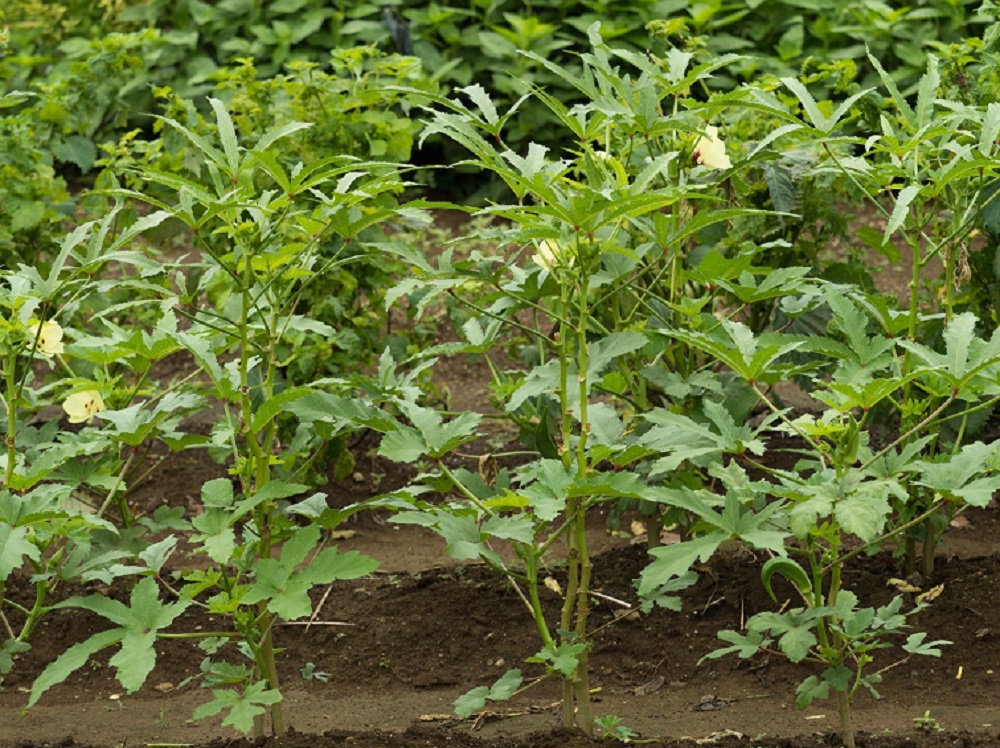Okra Fertilization Requirements

This post is also available in:
This post is also available in:
![]() Français (French)
Français (French) ![]() Deutsch (German)
Deutsch (German) ![]() Ελληνικά (Greek)
Ελληνικά (Greek)
Successful okra production depends on managing different components, with soil fertility being one of the primary considerations. Following soil test recommendations for lime and fertilizer should produce optimum yields under average climatic conditions as long as other aspects of standard good management are practised. Soil testing helps ensure a good economic return for finances spent on the purchase of fertilizer. Following soil test recommendations also helps protect the environment from pollution by excess fertilizer nutrients.
Soil Requirements
Okra is a warm-season crop that requires well-draining, nutrient-rich soil. The soil pH should be between 5.8 and 6.5 for optimal growth. The soil should also be loose and friable to promote good root development and drainage. If the soil is heavy or compacted, you should amend it with organic matter such as compost, aged manure, or other soil amendments to improve soil structure.
The growth of okra plants is sensitive balanced between foliage production and pod production. To prevent excessive plant growth, it’s recommended to avoid adding extra nitrogen. However, depending on rainfall, two or more side-dressings with a high-analysis nitrogen material may be needed. It is important to supply additional nitrogen late in the season at the time the “forms” or “blooms” are concentrated at the top of the plant.
Liming
The recommendation is to test the soil every two to three years to determine lime and fertilizer needs. Okra grows best at a target pH of 5.8 to 6.5. Liming to the target pH for the crop you intend to grow creates favourable conditions for rooting by neutralizing soil acidity and supplying calcium and/or magnesium..
Two types of lime are commonly available.
- Calcium carbonate (calcitic lime) and
- Calcium magnesium carbonate (dolomitic lime).
On coarse-textured (sandy) soils where leaching occurs more often or on soils with low levels of magnesium, it is best to use dolomitic lime 3-4 months before the crop is seeded.
Agricultural grade limestone provides maximum reactivity and effectiveness, especially when incorporated into the soil 6 to 8 inches deep in conventional tillage.
What is the NPK requirement of okra?
Before planting, soil tests are necessary to determine soil’s fertility. It is advisable to follow the recommendations from the soil analysis to prevent excessive plant vigour and poor yield. Apply needed P2O5, K2O, and lime according to soil test results.
If no soil test is made, a general recommendation is to apply:
- 20 kg of nitrogen,
- 30 to 40 kg of phosphorus (P205),
- 30 to 40 kg of potassium (K2O) per acre.
How often should you fertilize okra?
Top dressing with 15 kg of nitrogen when plants are 6 to 8 inches (15-20cm) tall and again 2 to 3 weeks later improves on the yield. A topdressing of nitrogen applied after the first harvest will help to prolong the harvesting period.
Okra is sensitive to boron deficiency and it’s recommended that a broadcast application of 0.5 to 1 kg /acre at planting. The lower rate is recommended on coarse-textured (sandy) soils to reduce the risk of toxicity.
Boron can be put out as a foliar application, but timing is very critical to achieve desired results. The recommended rate is 0.1kg/acre boron in foliar spray in sufficient water for coverage. Apply foliar boron at first flowering for higher yields in okra.
Read more:
- Hibiscus esculentus – Okra seeds
- Okra Pests, Disease and Weed management
- Okra: Harvest, Yield, Storage, and Post-harvest handling
- Okra Water Requirements and Irrigation Systems
- Soil Preparation and Planting in Okra Farming
- Okra Propagation
- Okra Fertilization Requirements
- Okra: History, Nutritional Value, and Plant Information
References:
Alsos, G.A.; Ljunggren, E.; Pettersen, L.T. Farm-based entrepreneurs: What triggers the start-up of new business activities? J. Small Bus. Enterp. Dev. 2003, 10, 435–443.
Barth, F. Economic Spheres in Darfur. In Themes in Economic Anthropology; Firth, R., Ed.; Routledge: London, UK, 1967. 75. Singer, A.E. Reflections on Eco-Preneurship. 2012.
Cavalli, D.; Cabassi, G.; Borrelli, L.; Geromel, G.; Bechini, L.; Degano, L.; Gallina, M. Pietro Nitrogen fertilizer replacement value of undigested liquid cattle manure and digestates. Eur. J. Agron. 2016, 73, 34–41.
Dijkxhoorn, Y., De, B., Piters, S., Brouwer, I., Hengsdijk, H. & Tichar, T. 2021. Enhancing fruit and vegetable consumption in low- and middle income countries through a food systems approach. The Hague, The Netherlands, Wageningen Economic Research.
FAO & WHO. 2019. Food control system assessment tool: Dimension A – Inputs and resources. Food safety and quality series No. 7/2. Rome, FAO.
Hoffmann, V. & Jones, K. 2021. Improving food safety on the farm: Experimental evidence from Kenya on incentives and subsidies for technology adoption. World Development, 143:
Jaffee, S., Henson, S., Unnevehr, L., Grace, D. & Cassou, E. 2019. The safe food imperative: accelerating progress in low- and middle-income countries. Agriculture and Food Series. Washington, DC, World Bank.
Kim, D.G.; Saggar, S.; Roudier, P. The effect of nitrification inhibitors on soil ammonia emissions in nitrogen managed soils: A meta-analysis. Nutr. Cycl. Agroecosyst. 2012, 93, 51–64.
Mencaroni, M.; Dal Ferro, N.; Furlanetto, J.; Longo, M.; Lazzaro, B.; Sartori, L.; Grant, B.B.; Smith, W.N.; Morari, F. Identifying N fertilizer management strategies to reduce ammonia volatilization: Towards a site-specific approach. J. Environ. Manag. 2021, 277, 111445.
Moumenihelali, H.; Sadighi, H.; Chizari, M.; Abbasi, E. Pluriactivity: An Entrepreneurial Strategy for Smallholder Farmers. J. Entrep. Agric. 2020, 6, 112–124.
Nitrogen Use Efficiency (NUE)—An Indicator for the Utilization of Nitrogen in Agriculture and Food Systems; EU Nitrogen Expert Panel: Wageningen, The Netherlands, 2015.
Sá, E.; Casais, B.; Silva, J. Local development through rural entrepreneurship, from the Triple Helix perspective. Int. J. Entrep. Behav. Res. 2019, 25, 698–716.
Sequeira, R.R. Factors Affecting Rural Entrepreneurship. Int. J. Res. Eng. Sci. Manag. 2020, 3, 239–240.
- https://extension.uga.edu/publications/detail.html?number=C627
- https://extension.uga.edu/publications/detail.html?number=C627
- https://www.uky.edu/ccd/sites/www.uky.edu.ccd/files/okra.pdf
- https://extension.okstate.edu/fact-sheets/okra-production.html








































































